Low crude oil prices hurting Oman’s property market
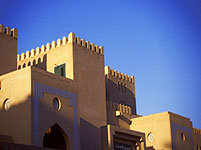 Residential property prices and rents in Oman declined by about 10% to 20% in 2016 from a year earlier, according to local real estate experts.
Residential property prices and rents in Oman declined by about 10% to 20% in 2016 from a year earlier, according to local real estate experts.
That's because crude oil prices plunged to an average of just US$40.1 per barrel in 2016, down by 29% from a year earlier and by more than 61% from US$103.2 in 2014.
"The economic situation has had a negative impact on employment and job generation....reducing demand for property in the capital area as fewer people are now willing to rent or buy properties," said Mohammed al Busaidy, the chairman of Oman Real Estate Association (OREA).
The value of real estate transactions in Oman plunged almost 70% to OMR1.42 billion (US$3.69 billion) during the first half of 2017, according to the National Centre for Statistics and Information (NCSI), compared to the same period last year.
The number of title deeds issued by the Ministry of Housing dropped 11.2%in H1 2017 as compared to a year earlier. The majority of title deeds issued were in Dhofar, Muscat, and North Al Batinah Governorates.
Mortgage contracts have fallen, both in number and value. In H1 2017, the value of mortgage contracts plummeted by 80.7% y-o-y to OMR 797.7 million (US$2.07 billion) while the number of contracts dropped 19.4% to 10,540.
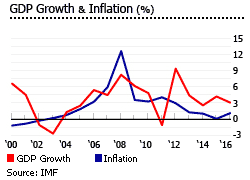
"The real estate sector will undoubtedly continue to be under pressure for as long as the present economic uncertainty prevails," said Christopher Steel of Savills Oman. "However, save for a few sectors which face continued pressure due to oversupply, we predict that 2017 will offer a period of calm and relative stability."
This was supported by Philip Paul of Cluttons, who believes that the real estate market will see only moderate price declines this year. "Steep corrections that happened in 2016 are unlikely," said Paul.
The economy is projected to expand by just 0.4% this year, down from annual growth rates of 3.1% in 2016, 4.2% in 2015, 2.5% in 2014, 4.4% in 2013, and 9.3% in 2012, according to the International Monetary Fund (IMF).
Oman had 551,058 housing units in 2010, 27.9% up on 2003. Arabic houses comprised 31.2% of the total housing stock; villas, 28.6%; apartments, 20.9%; rural houses, 3.2%; and improvised housing units, 2.4%.
Expats continue to buoy the property market
Property prices in Integrated Tourism Complex (ITC) developments have been more resilient, due to steady demand from expatriates who are less affected by low oil prices. In fact, employment of expats in the private sector increased 9.3%, as compared to a 6.4% rise for Omanis, according to the CBO.
Oman's real estate market began to be opened to foreigners in 2002, as part of the "Vision 2020" plan, which aimed to reduce Oman's dependence on oil revenues. GCC nationals first gained the right to own real estate, then in February 2006 other nationalities were also given the right to own real estate, but only in ITC developments.
Under current laws, expatriate owners automatically get residency rights for themselves and their immediate families when they buy property in designated ITC developments.
Growing expat numbers have fuelled a real estate boom in Oman. The expat population rose by more than 12% per annum during the period 2004-2016, and by July 2017 there were about 2.07 million expats in Oman, according to NSCI. The expatriate workforce reached 1,864,227 people in April 2017, a 5.7% increase from a year earlier.
Foreigners account for almost 90% of all workers in Oman's private sector, according to the Manpower Ministry. In Q2 2017, Oman's population of 4.58 million was 55% native Omanis and 45% expatriates, far from the 75:25 ratio of Omanis and expats in 2004. Oman's population is young, with a median age of 24.9 years.
The major ITCs such as Al Mouj Muscat (formerly The Wave), Muscat Bay(formerly Saraya Bandar Jissah), and Muscat Hills Golf and Country Club have led the country's housing market in terms of growth and value. These ITC developments have continuously attracted owners and tenants, with "virtually zero" vacancies and high rents, according to Savills Oman, due to their superior design, setting and facilities.
In Al Mouj Muscat and Muscat Hills, resale values of apartments are stable, according to some local property experts.
AVERAGE SALES PRICE IN THE SECONDARY MARKET FOR ITC PROPERTIES, Q2 2016 |
||||
| Property type | Property price (OMR) | Property price (USD) | ||
| Lowest | Highest | Lowest | Highest | |
| Apartment | ||||
| 1 bedroom | 48,000 | 120,000 | 124,708 | 311,769 |
| 2 bedroom | 65,000 | 170,000 | 168,875 | 441,673 |
| 3 bedroom | 90,000 | 340,000 | 233,827 | 883,347 |
| Villa | ||||
| 3-4 bedroom | 325,000 | 400,000 | 844,375 | 1,039,232 |
| 4-5 bedroom | 420,000 | 890,000 | 1,091,193 | 2,312,290 |
| 5+ bedroom | 490,000 | 1,300,000 | 1,273,059 | 3,377,503 |
| Source: Savills Oman | ||||
Aside from the continuous interest in the ITCs, there have been significant 'off plan' sales of new apartment developments in the Muscat neighborhood.
Newly launched off-plan apartment developments in Oman, 2016:
- In Ruwi/East of Centre, the main business and commercial district of Muscat, prices of one-bedroom apartments start at OMR 30,000 (US$77,942), according to Savills Oman. Two- and three-bedroom apartments are offered in the market for as low as OMR 45,000 (US$116,914) and OMR 60,000 (US$155,885), respectively.
- In Qurum, Muscat's upmarket suburb, prices of one-bedroom apartments range from OMR 38,000 (US$98,727) to OMR 45,000 (US$116,914). Prices of two- and three-bedroom apartments start from OMR 65,000 (US$168,875) and OMR 85,000 (US$220,837), respectively.
- In Al Khuwair, one-bedroom apartments are priced from OMR 38,000 (US$98,727) to OMR 45,000 (US$116,914). Prices of two-bedroom apartments start from OMR 65,000 (US$168,875) while for three-bedroom apartments, prices start from OMR 85,000 (US$220,837).
- In Bausher, one of the newly established residential areas in Muscat, one-bedroom apartments are priced from OMR 33,000 (US$ 85,737) to OMR 45,000 (US$ 116,914); two-bedroom apartments, from OMR 45,000 (US$ 116,914) to OMR 65,000 (US$ 168,875); and three-bedroom apartments, from OMR 70,000 (US$ 181,866) to OMR 75,000 (US$ 194,856).
- In Al Mawella/East of Centre, one-bedroom apartments are offered for as low as OMR 25,000 (US$ 64,952) while two-bedroom apartments are priced from OMR 30,000 (US$ 77,942). Prices for three-bedroom apartments range from OMR 35,000 (US$ 90,933) to OMR 40,000 (US$ 103,923).
Oman will open more areas to expat homebuyers
The governmenthas recently embarked on opening up more areas for expats and foreign homebuyers.
In April 2017, the Ministry of Tourism signed an agreement with Amouage Hotels and Resorts for the development of Naseem A'Sabah, an integrated tourism complex worth OMR400 million (US$1.03 billion). This will be located on North Al Mawleh Beach, in the governate of A'Seeb and will feature a five-star hotel, a marina, a yacht club and 696 housing units. Construction will begin next year.
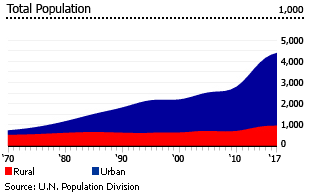
"Any expatriate living in the country can own a house in this first project that is built on the sea-reclaimed land off Mawaleh," said Tourism Minister Ahmed bin Nasser al Mehrzi.
"This project is part of our Oman Tourism Vision 2040 and with this, we aspire to achieve rapid development of tourism in the Sultanate," the tourism minister added.
Residential construction still rising
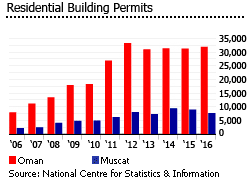
In 2016, residential building permits in Oman increased 2.14% to 31,868 units from a year earlier, according to the NCSI. That's up from an average of 31,000 units in 2011-16, 15,000 units in 2007-10 and 7,000 units in 2002-06.
Of the country's 11 governorates, Muscat accounted for about 24% of all residential building permits in the country in 2016, followed by Al Batinah North (18%), Al Batinah South (14%) and Ad Dakhliyah (11%). Dhofar recorded the biggest rise of 154% y-o-y in 2016, followed by Ash Sharqiyah North (23.8%), Al Wusta (20.5%), Al Batinah North (9.5%), Ash Sharqiyah South (5.8%), and Adh Dhahirah (3.7%).
In contrast, Musandam saw the biggest decline in residential building permits of 28.1% in during 2016. Permits also fell by 14.1% in Muscat, by 11.7% in Al Buraymi, by 3.1% in Ad Dakhliyah,and by 2.6% in Al Batinah South.
Rents continue to fall
A few years back, Cluttons forecast that a two-tier market would develop. Properties well-matched to tenant desires in terms of quality and design would have high occupancy rates and relatively stable rental values. Poorly built properties would have declining rents, and be mostly uninhabited.
This is largely what has happened. There has been a continuous drop in demand and declining rental levels for older-style properties in the established central areas. The take-up of these properties has been very slow, due to a surge of new modern apartments with amenities and finish meeting international standards.
During 2016, the average residential rent across Muscat stood at about OMR 700 (US$1,818) per month, down by 10.1% from a year earlier, according to Cluttons.
In some areas, however, rents have remained stable. There have even been slight rises in areas benefiting from the improved accessibility brought by the Expressway and new interchanges.
Monthly rents for two-bedroom apartments in central areas (excluding ITC's) during 2016 range from OMR 300 (US$ 779) to OMR 1,100 (US$ 2,858), according to Savills Oman, slightly higher than rents during 2015. Rents for 3 bed villas range from OMR 350 (US$909) to OMR1,750 (US$4,547). Rents for 4 bed villas are around OMR 450 (US$ 1,169) to OMR 2,500 (US$ 6,495).
Rents in Al Mouj Muscat (formerly known as The Wave) range from OMR 850 (US$ 2,208) to OMR 2,500 (US$ 6,495) depending on the housing type, while rents in Muscat Hills range from OMR 725 (US$ 1,884) to OMR 2,300 (US$ 5,976).
Cluttons predict that overall residential rents in Muscat will fall further by 5% to 7% during 2017.
More than 1,600 new rental apartments in central areas werecompleted over the last 12 months, according to Savills Oman.
MONTHLY RENTS, 2016 |
||||||
| Area | 2-BR apartments | 3-BR apartments | 4-BR apartments | |||
| OMR | USD | OMR | USD | OMR | USD | |
| Wadi al Kabir | 350 - 450 | 909 - 1169 | 450 - 500 | 1,169 - 1,299 | 450 - 650 | 1169 - 1689 |
| Ruwi | 300 - 350 | 779 - 909 | 375 - 450 | 974 - 1,169 | 450 - 500 | 1169 - 1299 |
| Darsait | 300 - 400 | 779 - 1039 | 375 - 500 | 974 - 1,299 | 450 - 650 | 1169 - 1689 |
| Al Wattaya | 350 | 909 | 350 - 450 | 909 - 1,169 | 450 - 550 | 1169 - 1429 |
| Qurum | 350 - 450 | 909 - 1169 | 800 | 2,078 | 850 - 2500 | 2208 - 6495 |
| Qurum Heights | 450 | 1169 | 550 - 900 | 1,429 - 2,338 | 950 - 2500 | 2468 - 6495 |
| Medinat al Ilam | - | - | 800 | 2,078 | 1100 - 2200 | 2858 - 5716 |
| Medinat Sultan Qaboos | 750 | 1949 | 1,100 - 1,750 | 2,857 - 4,545 | 1500 - 1800 | 3897 - 4677 |
| Al Khuwair | 450 - 750 | 1169 - 1949 | 650 - 800 | 1,688 - 2,078 | 850 - 2500 | 2208 - 6495 |
| Shati al Qurum | 775 - 850 | 2014 - 2208 | 1,000 | 2,597 | 1700 - 2500 | 4417 - 6495 |
| Ghubrah North | 550 | 1429 | 700 - 800 | 1,818 - 2,078 | 850 - 2000 | 2208 - 5196 |
| Ghubrah South | 450 | 1169 | 500 | 1,299 | 850 - 1000 | 2208 - 2598 |
| Al Mouj | 850 - 1100 | 2208 - 2858 | 1,200 - 1,500 | 3,117 - 3,896 | 1750 - 2500 | 4547 - 6495 |
| Muscat Hills | 725 - 775 | 1184 - 2014 | 850 - 1,100 | 2,208 - 2,857 | 1350 - 2300 | 3507 - 5976 |
| Azaiba | 525 - 750 | 1364 - 1949 | 800 - 900 | 2,078 - 2,338 | 850 - 1500 | 2208 - 3897 |
| Bausher | 600 - 650 | 1559 - 1689 | 875 - 975 | 2,273 - 2,532 | 1000 - 2000 | 2598 - 5196 |
| Seeb | 350 | 909 | 500 - 600 | 1,299 - 1,558 | 700 - 1000 | 1819 - 2598 |
| Al Khoud/Al Hail/Mawelah | 350 - 400 | 909 - 1039 | 450 | 1,169 | 550 - 800 | 1429 - 2078 |
| Source: Savills Oman | ||||||
A less restricted rental market
Rental laws in Oman were last changed by the amended Royal Degree (107/2010). New rules included:
- The rule that landlords may only increase rent every 3 years was modified. The parties can now agree otherwise.
- The maximum rent increase of 7% of the annual rent stipulated in the lease contract has been removed.
- The earliest period that a landlord can terminate a lease for commercial property was trimmed down to 5 years, from the previous 7, and from 4 to 3 years, in the case of residential properties.
- Landlords can now retrieve expenses incurred in lawsuits related to eviction notices served to non-paying tenants, due to a new legal procedure.
CBO imposes interest rate ceiling and lending cap on housing loans
The Central Bank of Oman (CBO) has enforced a 6% interest ceiling on personal loan interest rates (which include housing loans) since October 2013. In Q1 2017, the average lending rate was 5.12%, having declined somewhat in recent years.
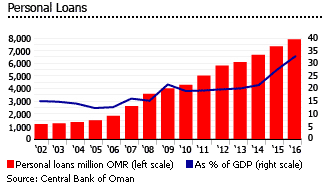
Residential housing loans were about 9.8% of total bank credits in 2016, up from 7% a year earlier and still well within the 15% ceiling stipulated in June 2014, according to the CBO.
Oil sector still dominates
Oil remains Oman's top revenue generator. In 2016, oil and gas revenues accounted for more than 68% of total government revenues and about 57.9% of total merchandise exports, according to the CBO.
Oman's diversification plan "Vision 2020" has been quite effective. Petroleum activities' contribution to Oman's total GDP in 2016 was just around 27.4%, down from 50.6% in 2013. The services sector accounted for around 53.5% of GDP in 2016, a sharp increase from 37.7% in 2013.
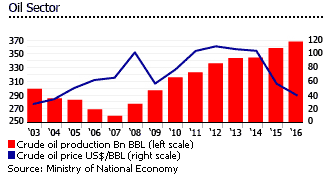
Yet this was partly the effect of lower oil prices. In real terms, Oman's GDP contracted by 5.1% in 2016, following a contraction of 13.8% in 2015, mainly due to the decline in crude oil prices, according to the CBO. The hydrocarbon sector fell by 23.7% in 2016 while the non-hydrocarbon sector grew slightly by 0.6% last year.
"Going forward, the hydrocarbon sector is expected to further slow down in 2017, despite some recovery in oil prices, due to lower production as part of the OPEC and other oil producers' agreement," said the central bank.
Oman's credit ratings downgraded; outlook negative
Oman's fiscal deficit widened to 21.4% of GDP in 2016, an alarmingly high deficit. Accordingly, Oman's sovereign debt long-term rating has been downgraded below investment grade, as low oil prices continue to erode the country's external reserves and finances.
- In May 2017, Standard & Poor's cut Oman's credit rating to junk, with negative outlook. This implies that there is a substantial chance of a further downgrade.
- Moody's Investors Service has downgraded Oman's credit ratings thrice this year. From A1, Oman's long-term issuer rating was cut to A3 in January, then to Baa1 in May 2017, and finally to Baa2 in July 2017. The outlook was also changed from stable to negative.
- In June 2017, Fitch Ratings affirmed the country's ratings at 'BBB' but downgraded its outlook from stable to negative, citing the weak economic activity and fiscal position.
Govt implements income tax changes, responding to the high fiscal deficit
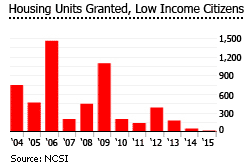
Oman's fiscal deficit rose by 21.5% to OMR5.3 billion (US$13.76 billion) in 2016. However the fiscal deficit is projected to decline to OMR3 billion (US$7.8 billion) this year, based on government estimates. The improvement is expected because in February 2017 the government made significant changes to the country's income tax laws, to address the fiscal deficit (Royal Decree 9/2017).
The key changes include:
- The standard corporate tax rate was raised from 12% to 15%
- A 3% tax has been introduced for micro businesses
- The tax-free threshold of OMR30,000 (US$78,000) has been removed
- Interest and dividend payments to non-residents are now subject to withholding tax of 10%
- The withholding tax exemption for ministries and other government bodies has been removed.
- Tax exemptions for hotels and tourist villages, mining, export of locally manufactured goods, agriculture, animal produce, fishing, education, and medical care have been removed.
- Exemptions for manufacturing companies have been limited to five years.
- Penalties and punishments for noncompliance have been strengthened.
Government housing projects, and subsidies for housing loans, havebeen cut substantially, compared to the previous year.
GOVERNMENT SUBSIDIES ON HOUSING LOANS |
||||
| Governorate | Amount (OMR) | No. of beneficiaries | Amount (OMR) | No. of beneficiaries |
| Muscat | 60,000 | 2 | 2,866,812 | 96 |
| Dhofar | 30,000 | 1 | 2,930,630 | 98 |
| Musandam | 0 | 0 | 0 | 0 |
| Al Buraymi | 0 | 0 | 388,025 | 13 |
| Ad Dakhliyah | 210,000 | 7 | 4,337,552 | 146 |
| Al Batinah North | 240,000 | 8 | 1,752,255 | 59 |
| Al Batinah South | 150,000 | 5 | 3,374,591 | 114 |
| Ash Sharqiyah South | 60,000 | 2 | 1,404,195 | 46 |
| Ash Sharqiyah North | 30,000 | 1 | 1,699,205 | 58 |
| Adh Dhahirah | 0 | 0 | 2,267,457 | 80 |
| Al Wusta | 0 | 0 | 0 | 0 |
| Oman | 780,000 | 26 | 21,020,722 | 710 |
| Source: NCSI | ||||